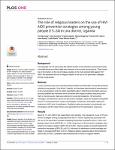| dc.identifier.citation | Murungi T, Kunihira I, Oyella P, Mugerwa M, Gift P, Aceng MJ, et al. (2022) The role of religious leaders on the use of HIV/AIDS prevention strategies among young people (15–24) in Lira district, Uganda. PLoS ONE 17(10): e0276801. https://doi.org/10.1371/journal.pone.0276801 | en_US |
| dc.description.abstract | Background
Young people (15–24 years) bear the highest burden of new infections and are particularly
vulnerable because of their highly risky behavior such as early sexual activity. There is paucity
of information on the role of religious leaders in the multi-sectoral fight against HIV/
AIDS. We examined the role of religious leaders in the use of HIV prevention strategies
among young people.
Methods
A cross sectional study was conducted between March and April 2021 among 422 randomly
selected young people in Lira district, Uganda. An interviewer administered a questionnaire
to the young people in order to collect quantitative data. A total 20 key informants were purposively
sampled and interviews were conducted with religious leaders using a key informant’s
interview guide. Data was collected on social demographics, HIV prevention
messages, and awareness about HIV prevention strategies. Data was analyzed using Stata
version 15 using proportions, means, percentages, frequencies, and logistic regression
analysis at a 95% level of significance. Qualitative data was analyzed using thematic content
analysis and the major themes were generated from the participants’ responses.
Results
About 57.1% (241/422) of the respondents were females. The prevalence of use of HIV prevention
strategies among young people was 69.4%. Factors significantly associated with
the use of HIV prevention included completing the primary level (aOR 4.95, p< 0.05), completing
at least A level (aOR 8.85, p < <0.05), Awareness of HIV prevention strategies advocated
for by religious leaders (aOR 0.02, p<0.001), religious leaders provided targeted HIV
prevention messages (aOR 2.53, p<0.01), Advocacy for abstinence outside marriage and
fidelity in marriage (aOR 35.6, p<0.01), Religious leaders preaching about HIV prevention
(aOR 4.88, p<0.001). Qualitative data indicated that a section of religious leaders recommended abstinence/faithfulness. Condom use was the most discouraged HIV prevention
strategy. However, most religious leaders agree with the fact that they have a role to
play in HIV prevention, which includes sensitization, teaching and organizing sermons
about HIV prevention.
Conclusion
The use of HIV prevention strategies advocated for by religious leaders among young people
was nearly 70%. This finding indicates that religious leaders have a role to play in HIV/
AIDS prevention among young people in the Lira district. This calls for the involvement of
religious leaders in HIV prevention programs tailored to prevent new infections of HIV
among young people. | en_US |

